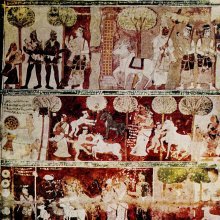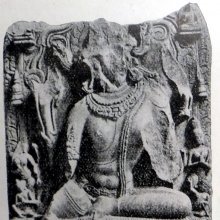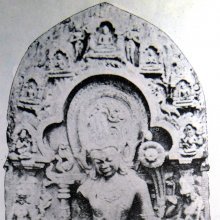N, Ṇ, Ṅ, Ñ: 3 definitions
Introduction:
N means something in Hinduism, Sanskrit, Hindi. If you want to know the exact meaning, history, etymology or English translation of this term then check out the descriptions on this page. Add your comment or reference to a book if you want to contribute to this summary article.
Images (photo gallery)
(+18 more images available)
In Hinduism
Vyakarana (Sanskrit grammar)
Source: Wikisource: A dictionary of Sanskrit grammarṆ (ण्).—(l) fifth consonant of the lingual class of consonants possessed of the properties, नादानुप्रदान, घोष, संवृतक-ण्ठत्व, अल्पप्राण (nādānupradāna, ghoṣa, saṃvṛtaka-ṇṭhatva, alpaprāṇa) and आनुनासिक्यः (ānunāsikyaḥ) (2) the mute letter ण् (ṇ) indicating the substitution of vrddhi (cf. P. VII. 2. 115-117) when attached to affixes; (3) the consonant ण् (ṇ) at the beginning of roots which is changed into न् (n); the roots, having ण् (ṇ) at the beginning changeable to न् (n), being called णोपदेशः (ṇopadeśaḥ) (4) ण् (ṇ) as a substitute for न् (n) following the letters ऋ, ॠ, र् (ṛ, ṝ, r), and ष् (ṣ) directly, or with the intervention of consonants of the guttural and labial classes, but occurring in the same word, Such a substitution of ण् (ṇ) for न् (n) is called णत्व (ṇatva); cf. P.VIII.4. I-39. For णत्व (ṇatva) in Vedic Literature; cf. R. Pr.V.20-28, T.Pr.VII.1-12. V.Pr.III.84-88;(5) the consonant ण् (ṇ) added as an augment to a vowel at the beginning of a word when it follows the consonant ण् (ṇ) at the end of the previous word; cf. P. VIII. 3. 32. In the Vedic Pratisakhyas this augment ण् (ṇ) is added to the preceding ण् (ṇ) and looked upon as a part of the previous word. 21
--- OR ---
1) Ṅ (ङ्).—Fifth letter of the guttural class of consonants having the properties कण्ठसंवृतत्व, घोष, नादानुप्रदान, अल्पप्राणत्व (kaṇṭhasaṃvṛtatva, ghoṣa, nādānupradāna, alpaprāṇatva) and आनुनासिक्य (ānunāsikya);
2) Ṅ.—The consonant ङ् (ṅ) getting the letter ,क (ka) as an aug-18 ment added to it, if standing at the end of a word and followed by a sibilant, e. g. प्राङ्कूशेते (prāṅkūśete) cf. ङ्णोः कुक् टुक् शरि (ṅṇoḥ kuk ṭuk śari) P. VIII. 3.28;
3) Ṅ.—The consonant ङ् (ṅ) which, standing at the end of a word and preceded by a short vowel, causes the vowel following it to get the augment ङ् (ṅ) prefixed to it; e. g, प्रत्यङ्ङास्ते (pratyaṅṅāste) cf. ङमो ह्रस्वादचि ङमुण् नित्यम् (ṅamo hrasvādaci ṅamuṇ nityam) P. VIII.3.32.
--- OR ---
1) Ñ (ञ्).—The nasal (fifth consonant) of the palatal class of consonants possessed of the properties नादानुप्रदान, घोष, कण्टसंवृतत्व, अल्पप्राण (nādānupradāna, ghoṣa, kaṇṭasaṃvṛtatva, alpaprāṇa) and आनुनासिक्य (ānunāsikya);
2) Ñ.—Mute letter, characterized by which an affix signifies वृद्धि (vṛddhi) for the preceding vowel; ञ् (ñ) of a taddhita affix, however, signifies वृद्धि (vṛddhi) for the first vowel of the word to which the affix is added;
3) Ñ.—A mute letter added to a root at the end to signify that the root takes verb-endings of both the padas.
--- OR ---
N (न्).—Fifth consonant of the dental class of consonants which is possessed of the properties घोष, नादानुप्रदान, अल्पप्राणत्व, संवृतकण्ठत्व (ghoṣa, nādānupradāna, alpaprāṇatva, saṃvṛtakaṇṭhatva) and आनुनासिक्य (ānunāsikya). In Panini's grammar the nasal consonant न् (n) (a)is added as an augment prescribed\ \नुट् (nuṭ) or नुम् (num) which originally is seen as न् (n), but afterwards changed into अनुस्वार (anusvāra) or परसवर्ण (parasavarṇa) as required, as for example in पयांसि, यशांसि, निन्दति, वन्दति (payāṃsi, yaśāṃsi, nindati, vandati) etc.; cf. P. VII. 1.58-73, VII. 1.79-83; VIII. 3.24; (b) is changed into ण् (ṇ) when it directly follows upon ऋ, ॠ, र् (ṛ, ṝ, r) or ष् (ṣ) or even intervened by a vowel, a semivowel except ल् (l), a guttural consonant, a labial consonant or an anusvara; cf. P. VIII. 4.1.1-31. (c) is substituted for the final म् (m) of a root, e. g. प्रशान्, प्रतान् (praśān, pratān) cf. P. VIII. 2.64, 65.

Vyakarana (व्याकरण, vyākaraṇa) refers to Sanskrit grammar and represents one of the six additional sciences (vedanga) to be studied along with the Vedas. Vyakarana concerns itself with the rules of Sanskrit grammar and linguistic analysis in order to establish the correct context of words and sentences.
Languages of India and abroad
Hindi dictionary
Source: DDSA: A practical Hindi-English dictionaryN in Hindi refers in English to:——the ultimate nasal letter of the third pentad (i.e. [tavarga]) of the Devnagri: alphabet..—n (ण) is alternatively transliterated as Ṇa.
...
See also (Relevant definitions)
Starts with (+9980): Asobhana, Buddhism in nepal, Dvarapalas, Humdavali, Janja, Kandita, Magaligenasu, Meredappu, Meregale, Meregallu, Meregattu, Merege, Meregedisu, Meregedu, Meregidu, Meremiru, Meresalu, Merudamda, Merudamde, Merumandara.
Ends with (+9980): A fenden, A mi qin, A phien, A-cakayacuran, A-karadayin, A-kon, A-mid o-raw a-tyan, A-ngubanan, Aab jamun, Aadan--pradaan, Aadikiran, Aadumilukkan, Aagamanaatmak-samanyikaran, Aagman, Aagney-chattan, Aagyaadheen, Aaiben, Aajivan, Aakaasagarudan, Aakhyan.
Full-text (+72808): Nam, Anunasikya, Namud, Makkat-katieluttu, Antahpata, Vinama, Dadana, Udac, Hastinapura, Nasikasthana, Paryatana, Vriddhinimitta, Prabalya, Na, Atarpana, Matsarya, Adivriddhi, Nakara, Pravinya, Anavadhana.
Relevant text
One of your search terms exceeds the minimun character amount per search term. This amount currently equals 2.
No search results for N, Ṇ, Ṅ, Ñ in any book or story.
Related products
(+40 more products available)











